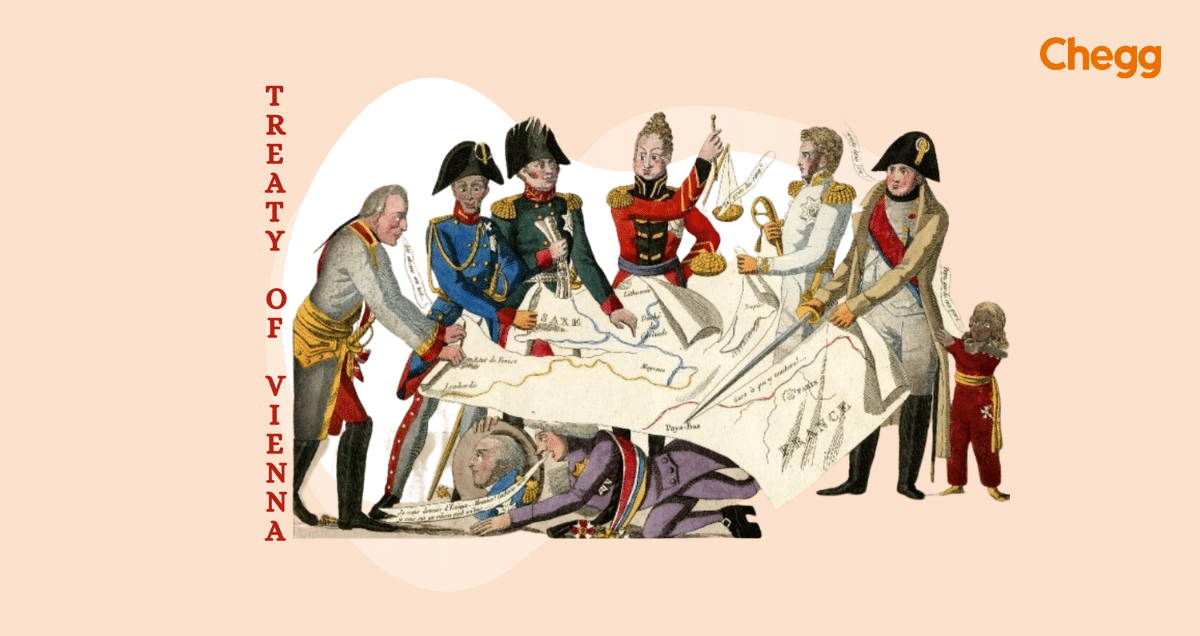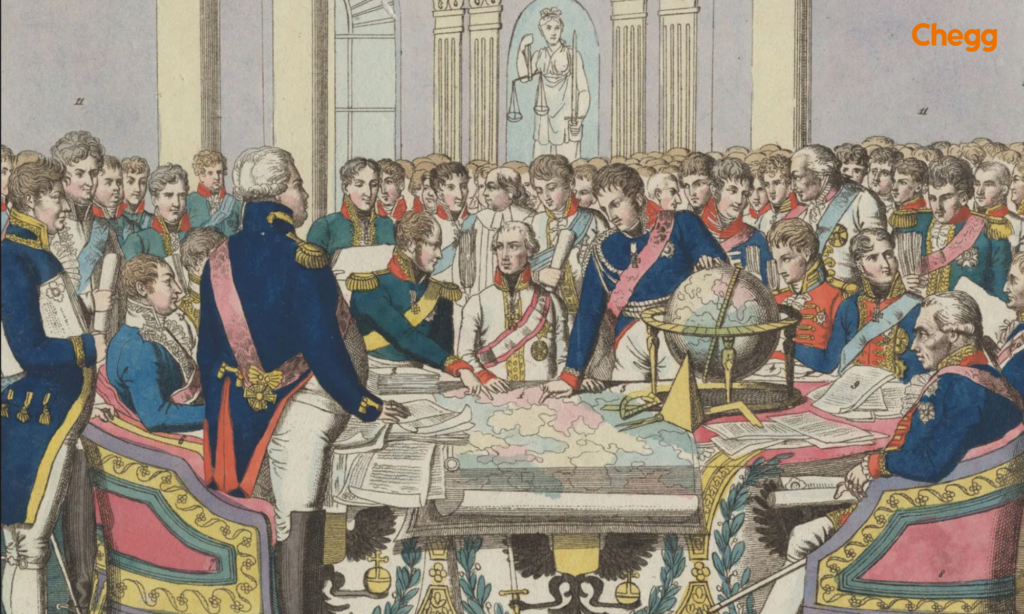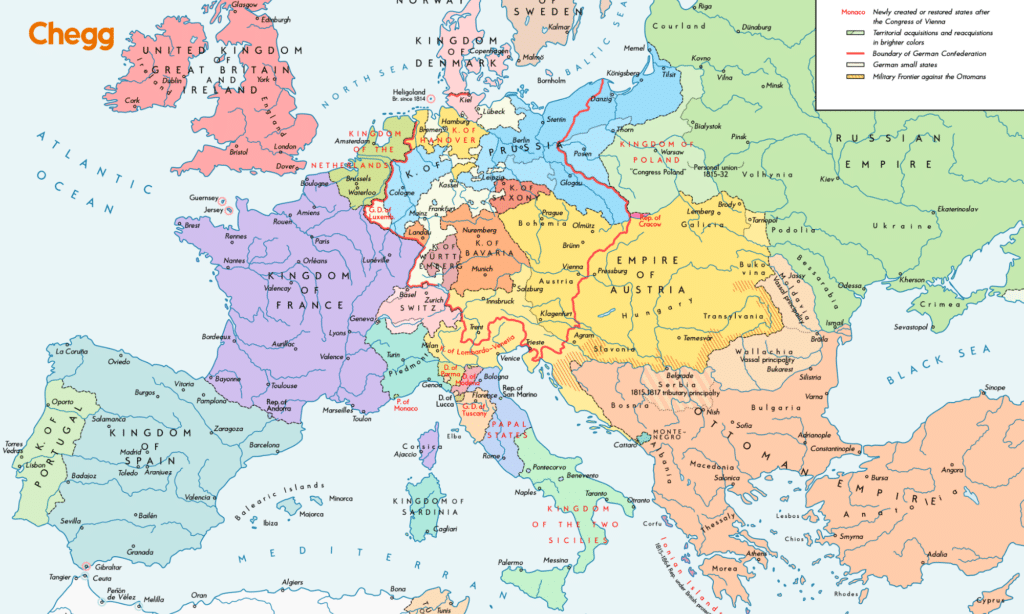
Quick Summary
Table of Contents
The Treaty of Vienna, also known as the Congress of Vienna, was a significant diplomatic agreement concluded in 1815. It involved key European powers—Austria, Great Britain, Prussia, and Russia—coming together to reorganize Europe following the end of the Napoleonic Wars. The treaty aimed to restore stability and order to Europe after the upheaval caused by Napoleon Bonaparte’s rule.
The primary goal of the Treaty of Vienna was to restore the European balance of power and undo the changes brought about by Napoleon. The treaty sought to reinstate the monarchies that had been displaced, redraw national boundaries, and establish a conservative political order to ensure long-term peace and stability. The treaty aimed to prevent future conflicts and maintain a stable geopolitical environment in Europe by addressing these changes.
The Treaty of Vienna, established during the Congress of Vienna from 1814 to 1815, was a pivotal diplomatic agreement that reshaped the political landscape of Europe following the Napoleonic Wars. This treaty aimed to restore stability and order to a continent significantly altered by years of conflict and revolutionary change.
The Treaty of Vienna, also known as the Congress of Vienna, marks a pivotal moment in European history. The Congress began its sessions in September 1814 and continued until June 1815, just before Napoleon Bonaparte’s defeat at the Battle of Waterloo. This diplomatic assembly involved the major European powers—Austria, Great Britain, Prussia, and Russia. It was convened to address the aftermath of Napoleon’s rule and restore stability to the continent.
The Congress of Vienna was crucial in reshaping Europe’s political landscape after years of turmoil caused by the Napoleonic Wars. Its primary aim was to overturn Napoleon’s revolutionary changes and reestablish a balance of power. The Treaty of Vienna resulted in one of the most extensive and influential diplomatic settlements in European history, setting the stage for a period of relative peace and stability in Europe.
Napoleon’s rule profoundly disrupted Europe’s political landscape, prompting a significant shift in how the continent was managed. In response to the upheaval caused by his aggressive expansion and the French Revolution, European policymakers aimed to prevent any future single power from dominating Europe. This led to establishing a new balance of power, formalized in the Treaty of Vienna, which became a cornerstone of European diplomacy in the years following his defeat.
With the end of the Napoleonic Wars, the Congress of Vienna sought to restore the pre-revolutionary order and reestablish conservative monarchies. The radical republican ideologies that had gained prominence during Napoleon’s rule were largely dismantled. The Congress also focused on redrawing national boundaries to create a balance of power that would prevent one nation from becoming too dominant. The goal of uniting Europe through alliances and mutual defense was to ensure that the major powers could collectively counteract any future threats and maintain stability across the continent. This diplomatic effort culminated in the Treaty of Vienna, which played a crucial role in shaping the political landscape of Europe for decades to come.
The Congress of Vienna was established in September 1814. It was formed under the influence of the Austrian Chancellor, Duke Metternich, where 8 participants acted as congress delegates. These participants included Austria, France, Portugal, Prussia, Russia, Spain, Sweden, and the United Kingdom.

The Congress of Vienna was established with certain objectives. These objectives include:
The years before the formation of the Congress of Vienna witnessed the French Revolution and the Napoleonic Wars. This undoubtedly caused great upheaval in Europe. Thus, the Congress’s major objective was to promote peace by avoiding future conflicts and maintaining economic stability.
The Congress of Vienna worked towards reshaping and redrawing Europe’s borders. It aimed to crumble the French empire and redistribute territories among the allied superpowers of Europe. Moreover, the monarchies overthrown during the Napoleonic era were restored in Europe.
The Congress of Vienna aimed to restore international peace, cooperation, and diplomacy orders. Major allied powers established a new system, the Concert of Europe, where they would meet to discuss and manage the administrative affairs of Europe.
Europe perceived nationalism and liberalism as threats. Therefore, the Congress of Vienna aimed to reestablish monarchies and conservative values. It focused on maintaining stability and preventing the outbreak of radical dogmas.
The Congress of Vienna aimed to maintain the status quo by promoting the balance of power and limiting the revolutionary ideas that emerged during the French Revolution. It successfully established a new equilibrium, thus maintaining peace in Europe.
The Congress of Vienna (1814-1815) was shaped by several influential leaders and diplomats who played crucial roles in its negotiations and decisions:
The Austrian Foreign Minister Metternich was a central figure at the Congress. He advocated for conservatism, stability, and a balance of power to restore Europe’s old regimes and curb revolutionary movements.
Tsar Alexander I was instrumental in shaping the Congress’s outcomes. He promoted the idea of a “Holy Alliance” to maintain Christian values and prevent future conflicts, significantly influencing territorial and political agreements.
The British Foreign Secretary Castlereagh focused on ensuring a balance of power to prevent any nation from dominating Europe. He was key in arranging compromises and promoting British economic and naval interests.
Representing France, Talleyrand skillfully secured a favorable position for his country despite its defeat. Aligned with other conservative leaders, he advocated for legitimacy and restoring traditional monarchies.
The Prussian statesman Hardenberg aimed to strengthen Prussia and support its territorial expansion, contributing to Prussia’s significant gains and shaping the future political landscape of Central Europe.
In 1815, the allied powers established the Treaty of General Alliance to fulfill specific objectives. The objectives were as follows:

The Vienna Congress was a diplomatic assembly/conference in Vienna, Austria. Various European delegates were part of this conference, whose primary aim was to promote peace and stability in Europe, especially after the Napoleonic Wars. The significant proposals and decisions of the Vienna Congress are:
The Napoleonic Wars and French Revolution caused a significant change in European politics, overthrowing monarchies. After the Vienna Congress, suggestions were made to reform the Bourbon dynasty for reinstatement in France. Similarly, the House of Orange and House of Savoy were recommended for restoration in the Netherlands and Italy. Other territories that the Vienna Congress proposed to restore were the Habsburg dynasty in Austria and the Hohenzollern dynasty in Prussia.
The Congress of Vienna proposed legitimacy and compensation for all of Europe. It also proposed redistributing administrative powers among nations so that no single country has much power. The significant powers established the Concert of Europe to discuss the administrative affairs of the continent.
The Congress of Vienna proposed to reshape the political boundaries of Europe to maintain peace and stability in the country. The Vienna Congress further proposed that the Roman Empire would replace the German confederation and Italy would turn into a smaller Independent state. The Congress also suggested turning the Netherlands into a new kingdom, including Belgium.
Prussia’s desire for complete control of Saxony was paralleled by Russia’s ambition to annex the majority of Poland. Such a strategy would have inevitably granted Russia an overwhelming amount of authority. Thus, the Vienna Congress proposed a solution of admitting France to the inner circle, and France would support Austria and Britain.
Europe underwent significant political changes after the Congress of Vienna in 1815. The Treaty of Vienna was primarily established to remap post-Napoleonic Europe and to restructure France’s powers. The Vienna Congress delegates and representatives from several other European countries contributed to the restructuring of the European map. As a result, the Russian provision retained most of Poland; however, these parts of Poland were not united with the territories Russia had acquired earlier in 1790, as outlined in the Treaty of Vienna.
Moreover, Prussia took over the province of Posen and most of Saxony. It also received parts of Rhineland and north-western Germany. The Congress of Vienna created the borderline of the Netherlands as a buffer zone to France. Germany was reorganized into a collection of 39 states. This new configuration replaced the fragmented structure of the Holy Roman Empire, which had previously been divided into around 360 separate entities.
Switzerland was considered a neutral state. However, Austria received several alpine provinces, Lombardy, and the Dalmatian coast. Great Britain was given many overseas territories. Several other territorial changes occurred under the Peace of Paris in June 1815.

Also Read:
The Shimla Agreement (1972) and Its Significance
Jawaharlal Nehru: Architect of Modern India
In international law, the Vienna Convention provides a framework for establishing, maintaining, and terminating diplomatic relations between sovereign states based on mutual consent. This international agreement governs the conduct of treaties among nations, ensuring a structured and orderly approach to diplomacy. The principles established in the Treaty of Vienna have influenced the development of the Vienna Convention, as they outline the rights and responsibilities of states in their interactions. They play a crucial role in promoting peaceful relations and cooperation on the global stage.
The Congress of Vienna, held from 1814 to 1815, was instrumental in reshaping Europe’s political landscape after the Napoleonic Wars and introduced a new era of multilateral diplomacy. This congress marked a significant shift towards collaborative international relations, setting the stage for modern diplomatic practices. The framework established during the Congress of Vienna laid the groundwork for developing international organizations and the principles of multilateral diplomacy, which continue to play a crucial role in global politics today. The Congress is thus recognized as a pioneering event in evolving international diplomatic norms and practices.
In the wake of Napoleon’s defeat, the Treaty of Vienna in 1815 aimed to redraw the map of Europe and restore stability. Here’s a breakdown:
Overall, the Treaty of Vienna aimed to create a conservative European order, restore monarchies, and prevent future French domination.
The Congress of Vienna and the Treaty of Vienna, also known as the Treaty of General Alliance, are pivotal in European history. Following the upheaval caused by the Napoleonic Wars and the French Revolution, Europe was left in disarray. The Congress of Vienna, which convened from 1814 to 1815, sought to restore order by restructuring Europe’s political and economic landscape and introducing a new approach to diplomacy known as multilateral diplomacy.
This approach involved multiple nations working together to address common concerns and maintain stability, setting a precedent for modern international relations. As the pioneer of multilateral diplomacy, the Congress of Vienna played a crucial role in creating international organizations and significantly influenced the development of diplomatic practices in the modern era.
Read More:
All About Writ and Writ Petition- A Lеgal Ovеrviеw
IMF vs. World Bank: Navigating the Global Financial Landscape
The National Food of India: Traditional Indian Cuisine
The main aim of the Treaty of General Alliance (Treaty of Vienna) was to restore stability in Europe after Napoleon’s defeat. It sought to reestablish the pre-Napoleonic order, including reinstating monarchies and redrawing national boundaries to maintain a balance of power and prevent future conflicts.
The Congress of Vienna was a diplomatic assembly of the major European powers—Austria, Great Britain, Prussia, and Russia—along with other European nations. It was convened to address the aftermath of Napoleon’s defeat, reshape the political map of Europe, and establish a framework for lasting peace.
There were 8 participants of the Congress of Vienna, namely Austria, France, Portugal, Prussia, Russia, Spain, Sweden, and the United Kingdom.
Eight countries attended the Vienna Congress including Austria, France, Portugal, Prussia, Russia, Spain, Sweden & the UK. Out of these countries, Sweden didn’t participate in the Treaty of General Alliance.
The 1815 Vienna Settlement, orchestrated by a committee of five from January 7 to February 13, established borders for territories north of the Alps and laid the groundwork for the settlement of Italy.
The Treaty of Vienna (1815) delayed German unification by restoring 39 fragmented states under Austrian control, forming the German Confederation. True unification occurred in 1871 under Bismarck.
The Treaty of Vienna was hosted by Austria and led by Austrian Chancellor Klemens von Metternich during the Congress of Vienna, aimed at restoring European stability after the Napoleonic Wars.

Authored by, Amay Mathur | Senior Editor




Amay Mathur is a business news reporter at Chegg.com. He previously worked for PCMag, Business Insider, The Messenger, and ZDNET as a reporter and copyeditor. His areas of coverage encompass tech, business, strategy, finance, and even space. He is a Columbia University graduate.
Editor's Recommendations
Chegg India does not ask for money to offer any opportunity with the company. We request you to be vigilant before sharing your personal and financial information with any third party. Beware of fraudulent activities claiming affiliation with our company and promising monetary rewards or benefits. Chegg India shall not be responsible for any losses resulting from such activities.
Chegg India does not ask for money to offer any opportunity with the company. We request you to be vigilant before sharing your personal and financial information with any third party. Beware of fraudulent activities claiming affiliation with our company and promising monetary rewards or benefits. Chegg India shall not be responsible for any losses resulting from such activities.